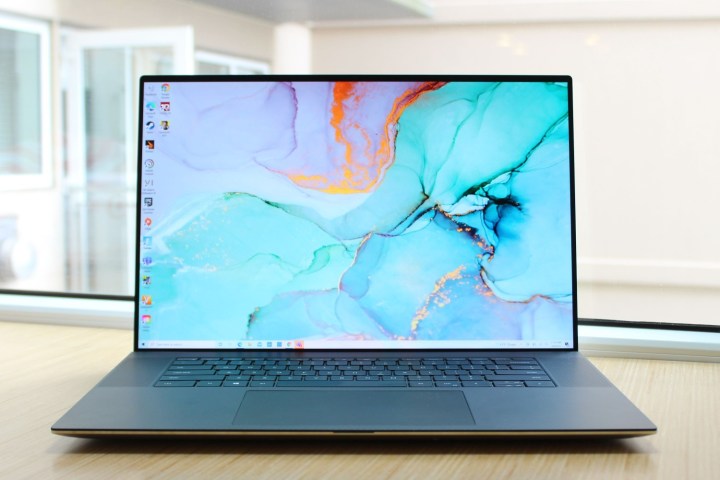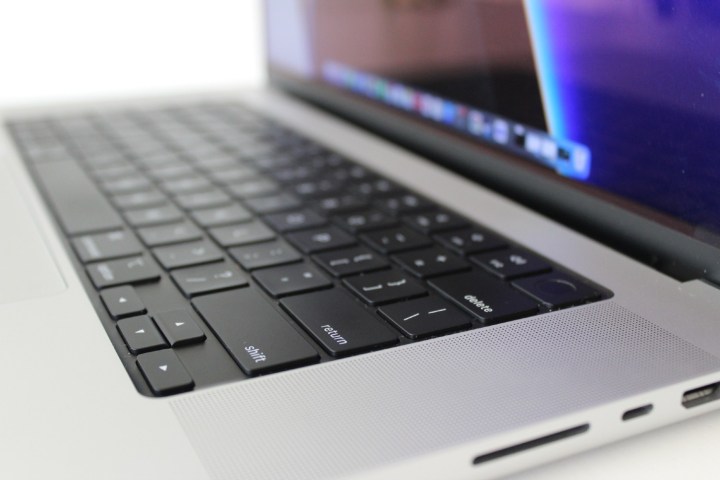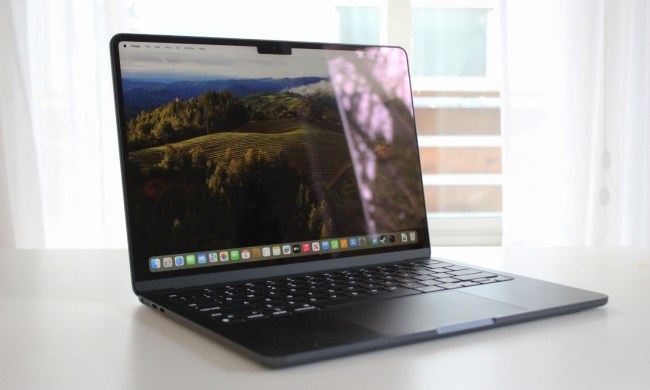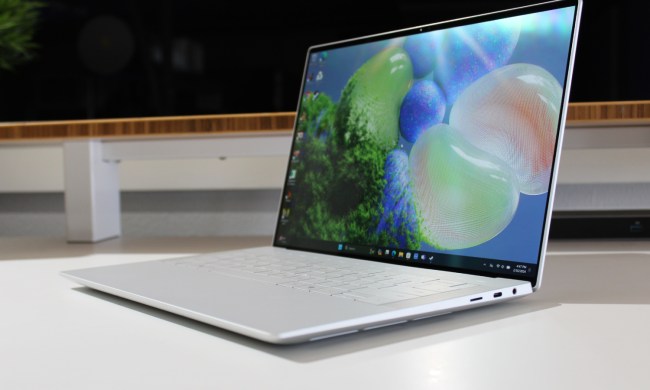If you’re looking for a laptop with a larger display for editing photos or videos, then you have a wide range of choices. Two of the best are Dell’s XPS 17 and Apple’s MacBook Pro 16, both of which are excellent laptops with prices to match. In addition, both laptops recently received updates to the internals that left almost everything else the same.
Choosing between these two machines comes down to some fine distinctions, which we’ll go over here. Which is the best laptop for you? Read on to find out.
Specs
| Dell XPS 17 | Apple MacBook Pro 16 | |
| Dimensions | 14.74 inches x 9.76 inches x 0.77 inches | 14.01 inches x 9.77 inches x 0.66 inches |
| Weight | 5.37 pounds | 4.8 pounds |
| Processor | Intel Core i5-13500H Intel Core i7-13700H Intel Core i9-13900H |
Apple M2 Pro Apple M2 Max |
| Graphics | Nvidia GeForce RTX 4050 (60W) Nvidia GeForce RTX 4060 (60W) Nvidia GeForce RTX 4070 (60W) Nvidia GeForce RTX 4080 (60W) |
Integrated |
| RAM | 8GB DDR5-4800MHz 16GB DDR5-4800MHz 32GB DDR5-4800MHz 64GB DDR5-4800MHz |
16GB 32GB 64GB 96GB (M2 Max) |
| Display | 17.0-inch 16:10 Full HD+ (1920 x 1200) IPS 17.0-inch 16:10 4K+ (3840 x 2400) IPS |
16.2-inch Liquid Retina XDR (3456 x 2234), 120Hz |
| Storage | 512GB PCIe SSD 1TB PCIe SSD 2TB PCIe SSD 4TB PCIe SSD 8TB PCIe SSD (2 x 4TB SSDs) |
512GB 1TB 2TB 4TB 8TB |
| Touch | Optional | No |
| Ports | 4 x USB-C with Thunderbolt 4 1 x 3.5mm audio jack 1 x SD Card reader |
3 x USB-C 4 with Thunderbolt 4 1 x HDMI 2.0 1 x 3.5mm audio jack 1 x SD Card reader |
| Wireless | Wi-Fi 6 and Bluetooth 5.2 | Wi-Fi 6 and Bluetooth 5.0 |
| Webcam | 720p with infrared camera for Windows 11 Hello | 1080p |
| Operating system | Windows 11 | MacOS Monterey |
| Battery | 97 watt-hours | 100 watt-hour |
| Price | $2,450+ | $2,499+ |
| Rating | 3.5 out of 5 stars | 5 out of 5 stars |
Design

The Dell XPS 17 and Apple Macbook Pro 16 are two of the best-designed and most well-built laptops on the market today. Both are constructed of CNC machined aluminum, both exhibit zero bending, flexing, or twisting in the lid, keyboard deck, or chassis, and both exude quality. Each laptop is also attractively elegant in its own way, with the MacBook Pro 16 exhibiting a more conservative, minimalist design while the XPS 17 has a sleeker, more streamlined appearance and the choice of black (carbon fiber) or white (glass fiber) keyboard decks that give it a more luxurious appearance. The fiber palm rests on the XPS 17 are more comfortable than the MacBook Pro 16’s cold metal, but that’s the only design element that stands out. You won’t choose between these two excellent machines based on their looks or build quality.
The XPS 17 is a bit larger in width, unsurprising given its 16:10 17-inch display compared to the MacBook Pro 16’s 16:10 16.2-inch panel. Both laptops have small display bezels, so they fit a lot of display into reasonably sized chassis. The XPS 17 is thicker than the MacBook Pro 16 at 0.77 inches versus 0.66 inches, even though the latest MacBook Pro 16 is thicker than its predecessors, and the Dell is also heavier at 5.37 pounds versus 4.8 pounds. These might technically be thin and light laptops, but they’re still on the larger side.
The MacBook Pro 16 enjoys the best laptop keyboard, with shallow travel but snappy, precise scissor switches that provide excellent feedback and a light touch. The XPS 17’s keyboard is deeper and also quite precise, with switches that offer a similarly snappy feel — but it’s not quite as comfortable as Apple’s keyboard for longer typing sessions.
Both are excellent, but the MacBook Pro 16 wins out. Both laptops also have superior touchpads, very large and with comfortable swiping surfaces. The MacBook Pro 16’s version is entirely haptic-driven, and it’s been perfected — you can’t tell the difference from the physical buttons on the XPS 17’s touchpad. It’s a toss-up which is better, but Apple’s touchpad is undoubtedly the technological winner. You can get a touch display with the XPS 17 but not with the MacBook Pro 16, so if that’s a preference, you’ll like the Dell.
Apple took a couple of positive steps back in designing the latest MacBook Pro 16. First was adding some thickness and weight where needed rather than fixating on being as thin and light as possible. The second is related in that connectivity improved thanks to the added thickness. Now, rather than just USB-C with Thunderbolt ports, you get a full-size HDMI 2.0 port and a full-size SD card reader to go with three USB-C with Thunderbolt 4 ports. The XPS 17 is all-in on the latter, with four USB-C with Thunderbolt 4 connections and a full-size SD card reader. Neither laptop has a USB-A port, so you’ll need a dongle with both to connect to legacy USB devices. Both laptops also feature Wi-Fi 6E and either Bluetooth 5.2 or 5.3.
The MacBook Pro 16 benefits from its 1080p webcam, while the XPS 17 retains a 720p version. The Dell incorporates an infrared camera for Windows 11 Hello facial recognition, and both laptops have fingerprint readers.
Performance

Everything changed when Apple moved all its MacBooks away from Intel, utilizing its own Apple Silicon CPUs instead. The latest MacBook Pro 16 offers a choice between the M2 Pro with 12 CPU cores and 19 GPU cores up to the M2 Max with 12 CPU cores and either 30 or 38 GPU cores. Both are incredibly fast processors, and we tested the MacBook Pro 16 with the M1 Pro. We’ve included the MacBook Pro 14 with the high-end M2 Max to give an idea of the performance at the high end, and the MacBook Pro 16 will likely be slightly faster yet.
The XPS 17 is offered with Intel 13th-gen 45-watt H-series CPUs, up to the Core i9-13900H. We tested the laptop with the Core i7-13700H, with 14 cores (six Performance and eight Efficient) and 20 threads. Our review unit equipped with the Nvidia GeForce RTX 4070 clocked at 60 watts.
In our CPU-intensive benchmarks, the XPS 17 was faster than the MacBook Pro 16 but fell behind the MacBook Pro 14’s M2 Max in all but our Handbrake test. The Dell was faster in single-core performance but couldn’t keep up with the M2 Max in multi-core. When we ran the Pugetbench Premiere Pro benchmark that can utilize the GPU to speed up various tasks, the MacBook Pro machines both took the lead. The RTX 4070 is a fast GPU, but Dell underclocked it and Apple’s GPU performance in creative apps was superior.
Both laptops are fast for productivity tasks, but if you’re a creator with demanding workflows, the MacBook Pro 16 will be a better choice.
| Geekbench (single/multi) |
Handbrake (seconds) |
Cinebench R23 (single/multi) |
Pugetbench Premiere Pro |
|
| Dell XPS 17 (Core i7-13700H / RTX 4070) |
Bal: 1901 / 12654 Perf: 1928 / 12911 |
Bal: 79 Perf: 71 |
Bal: 1933 / 13384 Perf: 1912 / 15462 |
Bal: 760 Perf: 848 |
| MacBook Pro 16 (M1 Pro 10/16) |
Bal: 1707/ 12605 Perf: N/A |
Bal: 95 Perf: N/A |
Bal: 1531 / 12343 Perf: N/A |
Bal: 977 Perf: N/A |
| MacBook Pro 14 M2 (M2 Max 10/38) |
Bal: 2668 / 14422 Perf: N/A |
Bal: 85 Perf: N/A |
Bal: 1608 / 14789 Perf: N/A |
Bal: 1093 Perf: N/A |
Display

You have two display choices with the Dell XPS 17, a 17-inch Full HD+ (1920 x 1200) IPS panel or a 4K+ (3840 x 2400) IPS panel. We tested the latter, and it was a superior display by IPS standards. The MacBook Pro 16 comes with just one display option, a 16.2-inch Liquid Retina XDR (Mini-LED) display running at 3456 x 2234.
Both displays are excellent for both productivity workers and creators. The XPS 17 has better colors and slightly higher brightness, but the MacBook Pro 16’s contrast was superior and its high dynamic range (HDR) support is second-to-none. It’s a toss-up as to which is the better display, and you can’t go wrong with either. Creators might prefer the wider colors on the XPS 17, but everyone else will appreciate the inky blacks and great HDR performance of the MacBook Pro 16’s Mini-LED display.
| Dell XPS 17 (IPS) |
MacBook Pro 16 (Mini-LED) |
|
| Brightness (nits) |
501 | 475 |
| AdobeRGB gamut | 100% | 100 |
| sRGB gamut | 100% | 90% |
| Accuracy (DeltaE, lower is better) |
1.33 | 1.04 |
| Contrast ratio | 1570:1 | 475260:1 |
Portability

As mentioned in the design section, both laptops are larger machines with a bit of heft. You’ll feel both in your backpack, but the MacBook Pro 16 is a bit thinner and lighter.
Battery life is a more prominent, differentiating feature. The XPS 17 (with 97 watt-hours of battery capacity) managed just 4.75 hours in our web browsing test that cycles through a series of popular and complex websites, and 5.25 hours in our video test that loops through a local Full HD Avengers trailer. Those aren’t great results, but unsurprising given the large 4K display and power-hungry components. However, the MacBook Pro 16 (with a 100-watt-hour battery) managed 18.5 hours on our web browsing test and over 23 hours on our video test, blowing the XPS 17 out of the water. Those are some of the best results we’ve seen, and it’s incredible to get so much longevity out of such a powerful laptop with its own power-hungry display. The M2 Pro/Max version will likely have equal efficiency.
If working away from a plug matters to you, then you’ll get days out of the MacBook Pro 16 and well under a day from the XPS 17. It’s really no contest.
The MacBook Pro 16 is just too fast and long-lasting to ignore
The XPS 17 can be had for as little as $2,049 for a Core i5-13700H CPU, 16GB of RAM, a 512GB solid-state drive (SSD), an RTX 4050, and a Full HD+ display. Max it out, and you’ll spend $5,389 for a Core i9-13900H CPU, 64GB of RAM, an 8TB SSD, the RTX 4080 GPU, and a 4K+ display. The XPS 17 starts at a mid-premium and ramps up quickly to ultra-premium levels.
The MacBook Pro 16, on the other hand, starts at $2,499 for an Apple M2 Pro CPU, 16GB of RAM, and a 512GB SSD. You can spend as much as a whopping $6,499 for an M1 Max CPU, 96GB of RAM, and an 8TB SSD. The MacBook Pro 16 is a costly laptop indeed.
The Dell XPS 17 is an outstanding laptop that any creator will love. It’s fast, well-built and attractive, and has a great display. But the MacBook Pro 16 is in another class entirely in its performance and battery life.


